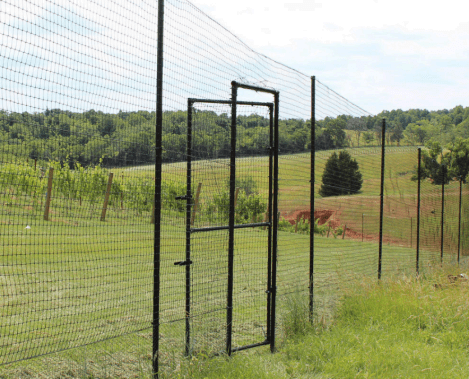Lyme disease has become one of the fastest-growing vector-borne illnesses in the United States. It has a well-documented connection to deer populations. As communities search for ways to protect themselves, one highly effective solution often goes overlooked: deer fencing.
While many homeowners think of fencing as a tool for keeping animals out of gardens or away from ornamental plants. The reality is that it can play a critical role in public health. Specifically, well-designed deer fencing can reduce the presence of deer-tick hosts around residential areas, lowering the risk of Lyme disease transmission.
This article explores how fencing fits into a broader Lyme disease prevention strategy. Along with why investing in the right barrier can benefit more than just your landscaping.
Understanding the Link Between Deer and Lyme Disease
Lyme disease is mainly transmitted through the bite of infected black-legged ticks. These are commonly referred to as deer ticks. However, such ticks often feed on white-tailed deer, which serve as the primary host for adult ticks to reproduce and spread.
When deer regularly visit residential areas, they bring ticks with them, dropping them into backyards, gardens, and woodlines where humans and pets are at risk. And while ticks also feed on rodents and birds, studies show that reducing deer access can drastically reduce tick abundance. Eventually, breaking the reproductive cycle of these parasites.
Research from several northeastern states shows that limiting deer populations through physical exclusion can decrease tick density by up to 90% in some cases. That’s where deer fencing becomes more than just a convenience, it becomes a form of environmental protection.
Why Traditional Solutions Fall Short
Homeowners concerned about Lyme disease often focus on tick repellents, landscape management, or pesticide treatments. While these measures can offer some protection, they often provide only short-term results or require repeated application to remain effective.
- Repellents may keep ticks away temporarily, but don’t remove them from the environment.
- Pesticides can often pose risks to pets and groundwater if not taken care of properly.
- Landscape adjustments, like removing leaf litter and tall grass, help to some extent, but don’t address the root issue: deer bringing ticks into the area.
Deer fencing, on the other hand, addresses the problem at its source by physically excluding the largest host of adult ticks.
To learn more at deerfencing.com, visit the resource section on how fencing solutions can complement other Lyme prevention strategies.
What Makes a Good Deer Fence?
To effectively deter deer and reduce Lyme disease risk, fencing must meet certain criteria. Here are the key components of a successful deer fencing setup:
1. Height: Deer are capable jumpers, and fencing must be at least 7 to 8 feet tall to prevent them from leaping over.
2. Durability: Materials like high-tensile wire mesh or UV-resistant polypropylene are built to withstand the elements and long-term use.
3. Minimal Visibility: Black-coated mesh is harder for deer to see, which helps discourage attempts to jump.
4. Low Ground Clearance: Fencing should be installed close to the ground or trenched below to prevent smaller animals or fawns from crawling underneath.
5. Secure Anchoring: Posts and support systems must be solid to hold tension and prevent sagging over time.
Fencing that meets these criteria not only keeps deer out but also maintains its effectiveness year after year with minimal maintenance.
Residential and Community-Level Impact
While installing a fence around a single backyard can reduce deer presence on that property. Leading larger-scale applications provides greater public health benefits. Communities, parks, and neighbourhood associations are increasingly looking at deer fencing to protect shared green spaces and reduce Lyme disease cases collectively.
In suburban or semi-rural areas where deer populations are high, coordinated fencing efforts across multiple properties can help create “safe zones”. Eventually, leading families, children, and pets to be less likely to come into contact with disease-carrying ticks.
Additionally, fencing doesn’t involve the controversial or often impractical methods of culling deer populations or using chemical repellents across large areas. It’s a non-invasive, sustainable solution that prioritizes both human safety and animal welfare.
Added Benefits of Deer Fencing
Beyond health protection, installing deer fencing offers a variety of secondary benefits that make it an attractive long-term investment:
- Garden & Crop Protection: Prevent deer from damaging vegetable beds, fruit trees, or ornamental plants.
- Fewer Vehicle Collisions: Keeping deer away from road-adjacent properties reduces the risk of vehicle collisions.
- Landscape Stability: By limiting browsing, fencing helps preserve the health of native plant ecosystems.
- Peace of Mind: Knowing your outdoor space is protected from unwanted wildlife visits adds a layer of security to everyday living.
To learn more at deerfencing.com, explore case studies and customer stories highlighting the long-term impact of strategic fencing.
Final Thoughts
Lyme disease isn’t just a seasonal nuisance, it’s a growing concern that affects families, pets, and communities at large. While many prevention strategies offer limited protection, deer fencing targets one of the most critical parts of the disease cycle by reducing tick-host access to residential areas.
Investing in a durable, well-installed fence is about more than keeping deer off your property. It’s about creating safer outdoor spaces and taking an active step toward long-term health protection.
Whether you’re a homeowner in a tick-prone region or part of a community group looking for preventative measures. Deer fencing offers a practical, environmentally sound approach that pays off in safety and peace of mind.








